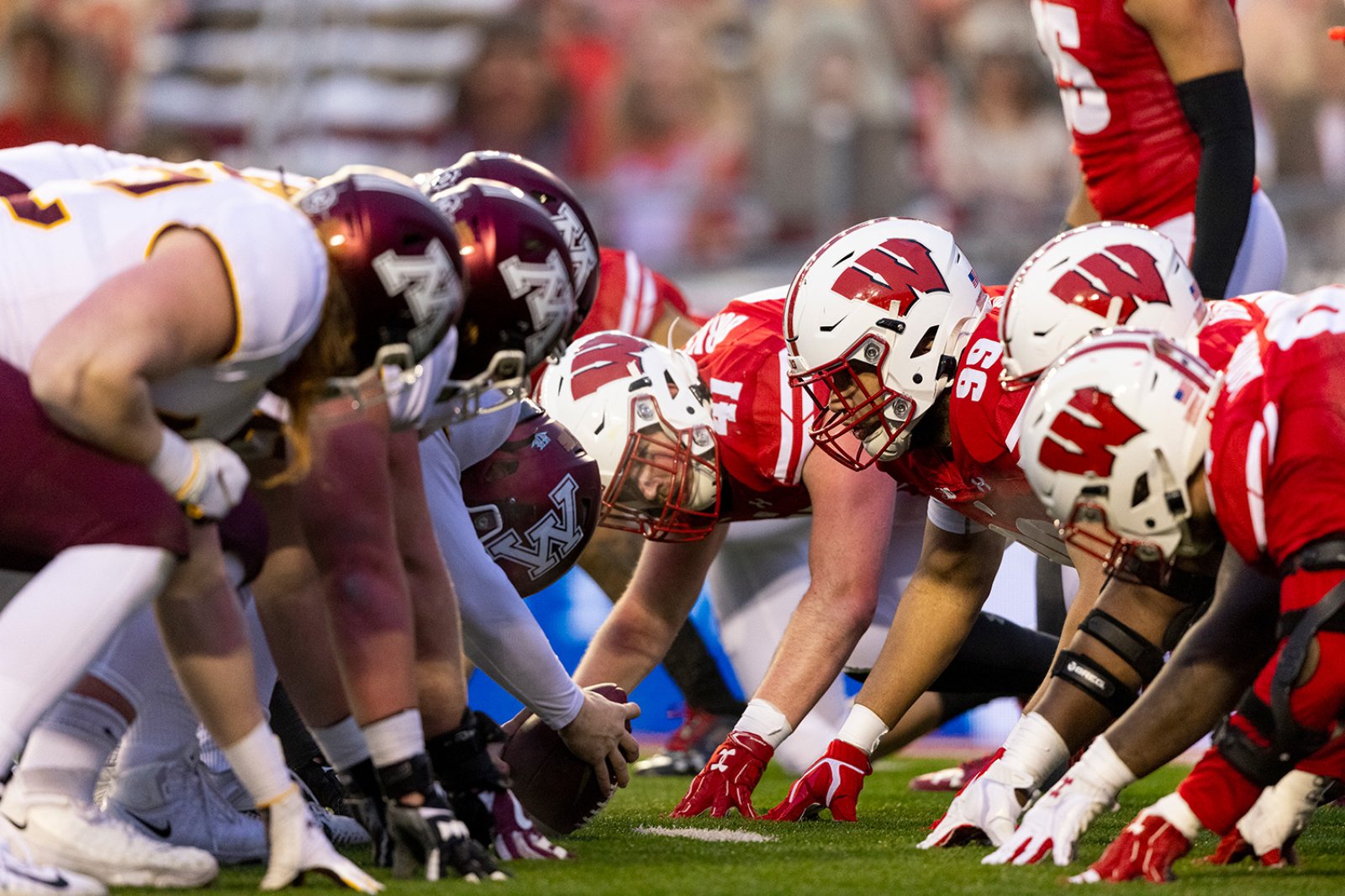
The Badgers’ Worthy Opponent
The sports rivalry between the UW and the University of Minnesota has produced legends and lore for the ages.
There is general agreement that the game that took an already fierce college athletics rivalry and sent it soaring to new levels of impassioned intensity occurred November 24, 1962, in Madison.
The border-battle football rivalry between the University of Wisconsin Badgers and University of Minnesota Gophers was already one of the oldest in the country, dating to 1890.
Other sports — notably men’s and women’s hockey — would eventually contribute their own chapters to the storied Badger-Gopher matchups, but in 1962, football was king. What happened in Camp Randall Stadium on that November day still resonates, more than six decades later.
“The most significant game of all in a highly significant rivalry,” says Joel Maturi, a Minnesota native who was an assistant athletic director at UW–Madison and, later, athletic director at Minnesota.
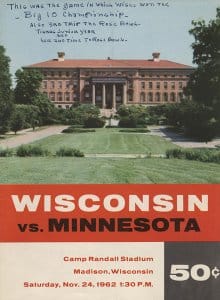 Bill Brophy, another native Minnesotan who served as sports editor of the Wisconsin State Journal in Madison, was a young boy in 1962. But he remembers.
Bill Brophy, another native Minnesotan who served as sports editor of the Wisconsin State Journal in Madison, was a young boy in 1962. But he remembers.
“My dad took the train to Madison for the game,” Brophy says. “He was still mad a month later. He told me the story. He said Minnesota got screwed.”
The game had large implications — the winner would go to the Rose Bowl.
The Gophers led, 9–7, when the Badgers tried to mount a late fourth-quarter drive starting at their own 20-yard line. Three completions from Ron Vander Kelen ’64 to his star receiver, Pat Richter ’64, JD’71 (later UW athletic director), brought the ball to the Minnesota 43-yard line. Two and a half minutes to play.
The next play lives in infamy for Gopher fans. Vander Kelen was rushed and hit by Minnesota’s star defensive tackle, Bobby Bell. His wobbly pass was intercepted, and joyous Gopher fans began dreaming about Pasadena in January.
Except a 15-yard penalty was called on Bell for roughing the passer. And soon another 15 yards was tacked on for “unsportsmanlike remarks from the sidelines,” as Sports Illustrated put it.
Suddenly the Badgers were at the Minnesota 13-yard line.
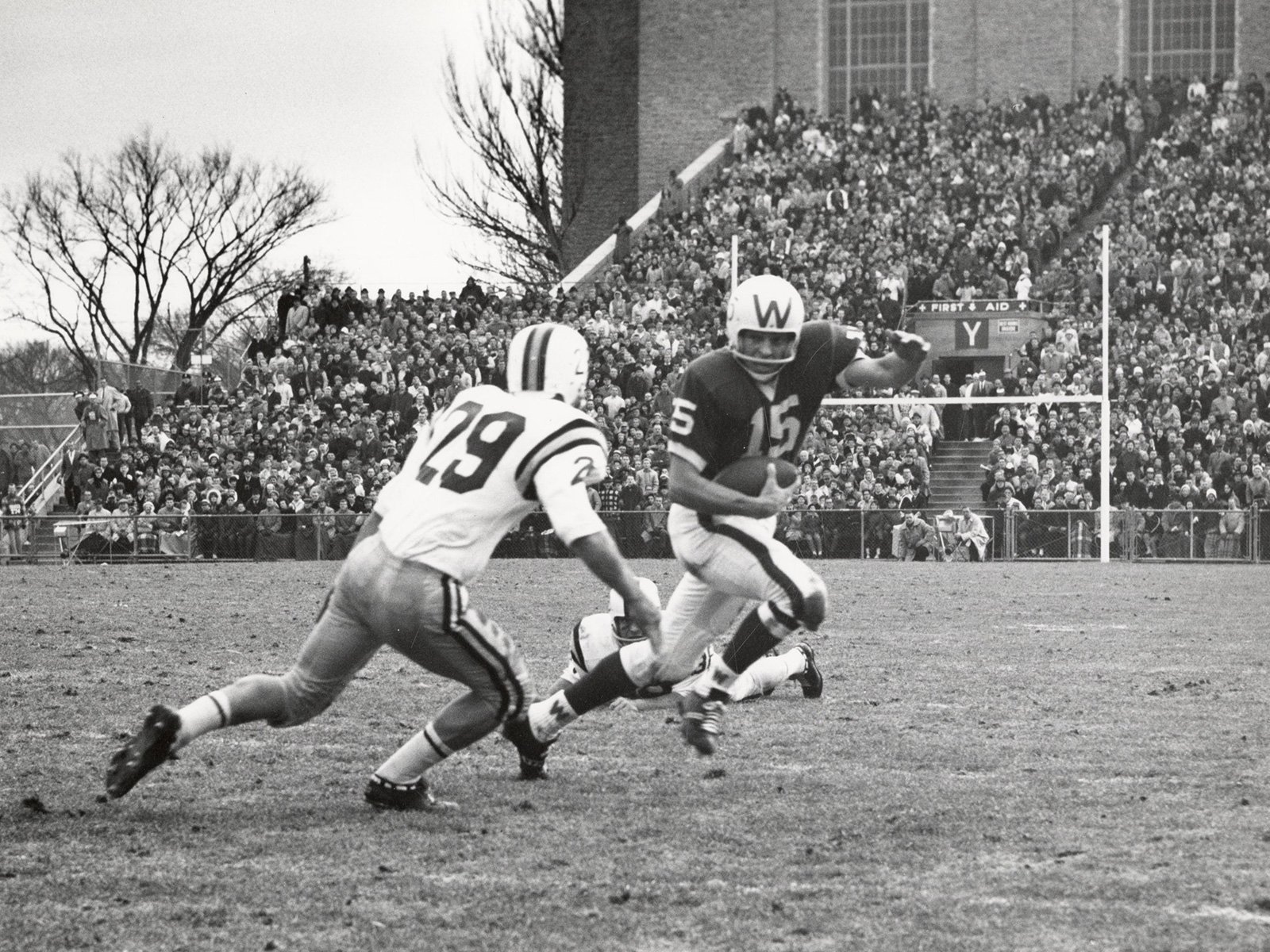
“We still had to take it in,” Richter recalls, 63 years later. “I’ve seen a lot of crazy calls in my life, but you have to play it as it is and execute.”
They scored three plays later, winning 14–9. Minnesota players and fans were outraged.
“I touched the ball,” Bell told Sports Illustrated. “It was a legitimate rush.”
Crazy calls, the introduction of a slab of bacon, then an axe, and a heated personality clash between two charismatic hockey coaches — the rivalry between Badgers and Gophers athletics has produced legends and lore for the ages.
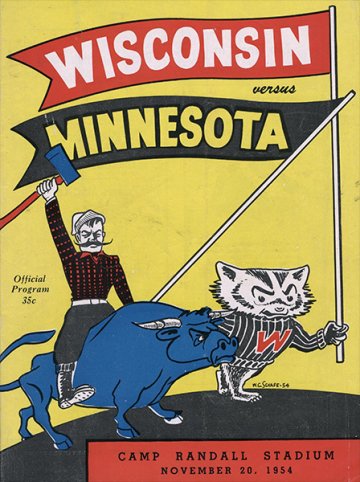

“Badgers May Abolish Football”
Incredibly, the football series, which began in 1890 and will continue this year in Minneapolis on November 29, is currently dead even. Each team has won 63 games, and there have been eight ties.
In 2010, when the Big Ten Conference added Nebraska and went to two divisions in football, Minnesota and Wisconsin were split up. Though teams would be allowed a crossover game, some discussions of scheduling did not include a Gophers vs. Badgers matchup.
“I think both [then UW athletic director] Barry Alvarez and I said that a game had to happen,” recalls Maturi, who then led Gopher athletics. “I made the comment at a meeting, ‘If we don’t play each other, I’m going to get fired.’ ”
The game happened, and indeed, only once in the 135-year history of the rivalry did the Badgers and Gophers not meet on the football field.
What caused them not to play in 1906 was the culmination of a decade-plus rash of serious injuries that led some to question whether college football should continue.
News accounts from those early games tell the story. Reporting on the first Badgers-Gophers meeting, in November 1890 — won 63–0 by Minnesota — the Green Bay Weekly Gazette noted: “The usual number of accidents occurred during the game — Leary of the Minnesota team having his nose broken; of the UW men, Davidson sprained his ankle; Sumner was quite seriously injured by colliding with one of his opponents, and Kerr, the captain of the team, was seriously injured about the head in a collision. He protested that he was not seriously hurt and continued playing but finally fell unconscious and was carried off the field.”
By 1906, university faculty and administrators discussed doing away with the sport. A March 1906 Wisconsin State Journal headline read: “Badgers May Abolish Football.”
There was a mass student protest on campus. Football survived, but the Badgers-Gophers game was suspended, as a Minneapolis Star Tribune columnist explained in 1973: “The reason they didn’t play in 1906: college football with its mass formations had become too brutal. President Teddy Roosevelt ordered the colleges to suspend their most intense rivalries. … Roosevelt directed the rules committee to create a more open game. Thus the forward pass was introduced.”
An Axe and a Slab of Bacon
By 1930, the history and intensity of the Badgers-Gophers rivalry led a Minneapolis dentist named B. Fouch — a 1914 Minnesota alumnus — to create an unusual trophy.
Carved from black walnut, “it is two feet long and one foot wide,” the Star Tribune reported, “has a raised football in the center, the word ‘Bacon’ at each end, and the initial ‘M,’ reversible to a ‘W’ when the slab is hung the other way.”
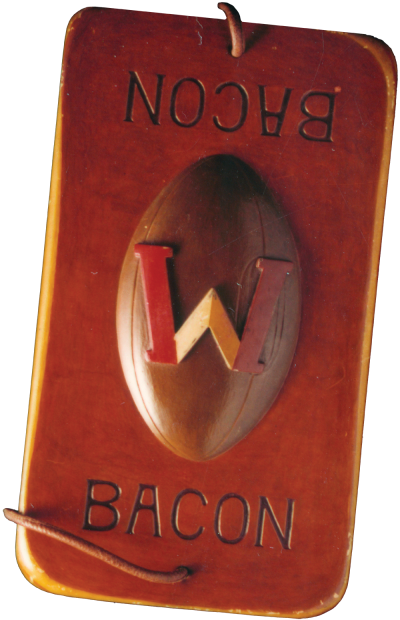
UW Athletics
It became known as the “slab of bacon,” with the winner of the Badgers-Gophers football game gaining possession until the next meeting. It changed hands across a dozen years, and then, in 1943, the slab of bacon disappeared after a Gopher victory in Minnesota.
A Star Tribune article the Monday following the game said a Badgers manager had tried to present it in the Gophers’ locker room, only to be told “all trophies are frozen for the duration” of World War II.
The slab of bacon wasn’t seen again in public for 50 years, when it was unearthed in Madison in 1994 by a UW athletics intern cleaning a storage room. Oddly, it hadn’t been completely ignored. Somebody had written on it the scores of the Badgers-Gophers games from 1943 to 1970 in thick black marker, according to a 2023 New York Times series on college sports mysteries.
By the time the missing slab was discovered, the rivalry had another trophy: the Paul Bunyan Axe, donated by the Badgers’ National W Club. It was presented for the first time in Minneapolis in January 1949, at halftime of the Badgers-Gophers basketball game. Gopher football legend Francis “Pug” Lund accepted it, Minnesota having won the 1948 game 16–0.
Today’s tradition of the winning team feigning to chop down the goalposts with the axe did not happen immediately. Richter, who played in the early 1960s, said he and his teammates never swung the axe.
Minnesota sports historian Ryan Barland looked into the origin of the chopping and couldn’t pinpoint it precisely, noting that “the practice was started in the 1980s (at the earliest).”
The chopping is a big deal now. Andy Crooks ’08 was a high school All-State player in Wausau in the early 2000s prior to coming to the UW, where he first played linebacker, then tight end. Crooks always wanted to be a Badger, but his high school girlfriend’s parents were Gophers who serenaded him with the Minnesota fight song.
“That ‘Ski-U-Mah’ stuff,” Crooks says.
He wasn’t having it. Crooks arrived in Madison fully versed in the rivalry.
“There is not a better feeling,” he says, “than taking that axe and chopping those posts down. There’s nothing more disheartening than when a team runs across the field and takes [the axe] from you.”
The original Paul Bunyan’s Axe is now in possession of the College Football Hall of Fame, the W Club having replaced it in 2000.
An Upset and an Abdication
In a memorable 1961 game in Minneapolis, with a Rose Bowl bid on the line for Minnesota, the Badgers upset the Gophers, 23–21. Richter caught two touchdown passes, and Minnesota fans were furious.
The loss left the Ohio State Buckeyes with a better record than the Gophers. Remarkably, however, the Ohio State faculty voted 28–25 to reject the Rose Bowl bid.
A faculty member told Sports Illustrated: “We’re upset that the image of Ohio State is that the school is merely an appendage to the football team.”
There was a near riot in Columbus. Some 2,000 students “burned members of the faculty in effigy,” the magazine reported, “snake-danced down the main street, and surrounded the capitol building.” The bid went instead to Minnesota, and the Gophers won the 1962 Rose Bowl, 21–3, over UCLA.
From Ecstasy to Shambles
Even the fiercest rivalries have ebbs and flows, and for a time — a decade starting in 2004 — the football Badgers dominated the Gophers.
One game seems to particularly haunt Gopher fans. In 2005, in Minneapolis, the Gophers had the ball and a 34–31 lead with less than a minute to go. Forced to punt near their own end zone, the unthinkable happened. The Badgers blocked the punt and recovered the ball for a touchdown, securing a 38–34 Badgers win.
“It was a home game,” says Minnesota’s Barland, who was a Gopher student at the time. “We were beating our rivals. To go from that ecstasy to shambles was a foundational part of my college experience.”
Five years after the blocked punt, in October 2010, UW head football coach Bret Bielema drew the ire of Gopher fans when he had the Badgers go for a two-point conversion after taking a 41–16 lead with under seven minutes to play in Madison.
Was Wisconsin running up the score?
“A very poor decision,” Gophers coach Tim Brewster said afterward. “It was wrong.”
“We Bring Out the Best in Each Other”
The Badgers-Gophers rivalry has also been heated in both men’s and women’s hockey.
The NCAA sanctioned women’s hockey in 2000, and since then the Badgers have won eight national championships and the Gophers six.
Writing about the rivalry in 2019, the Star Tribune called it “fierce.” The occasion was the 2019 national championship game between the Badgers and Gophers. The Badgers won, 2–0, behind a 27-save performance by goaltender Kristen Campbell ’20.
Gophers coach Brad Frost said, “We bring out the best in each other.”
The all-time series in women’s hockey is nearly as close as that of football. When the Badgers and Gophers met last, in March 2025, in the semifinals of the Frozen Four, each team had 57 wins, and there had been 16 ties.
The Badgers won, 6–2, securing a one-win advantage in the border-battle series and going on to win their NCAA-record eighth national championship.
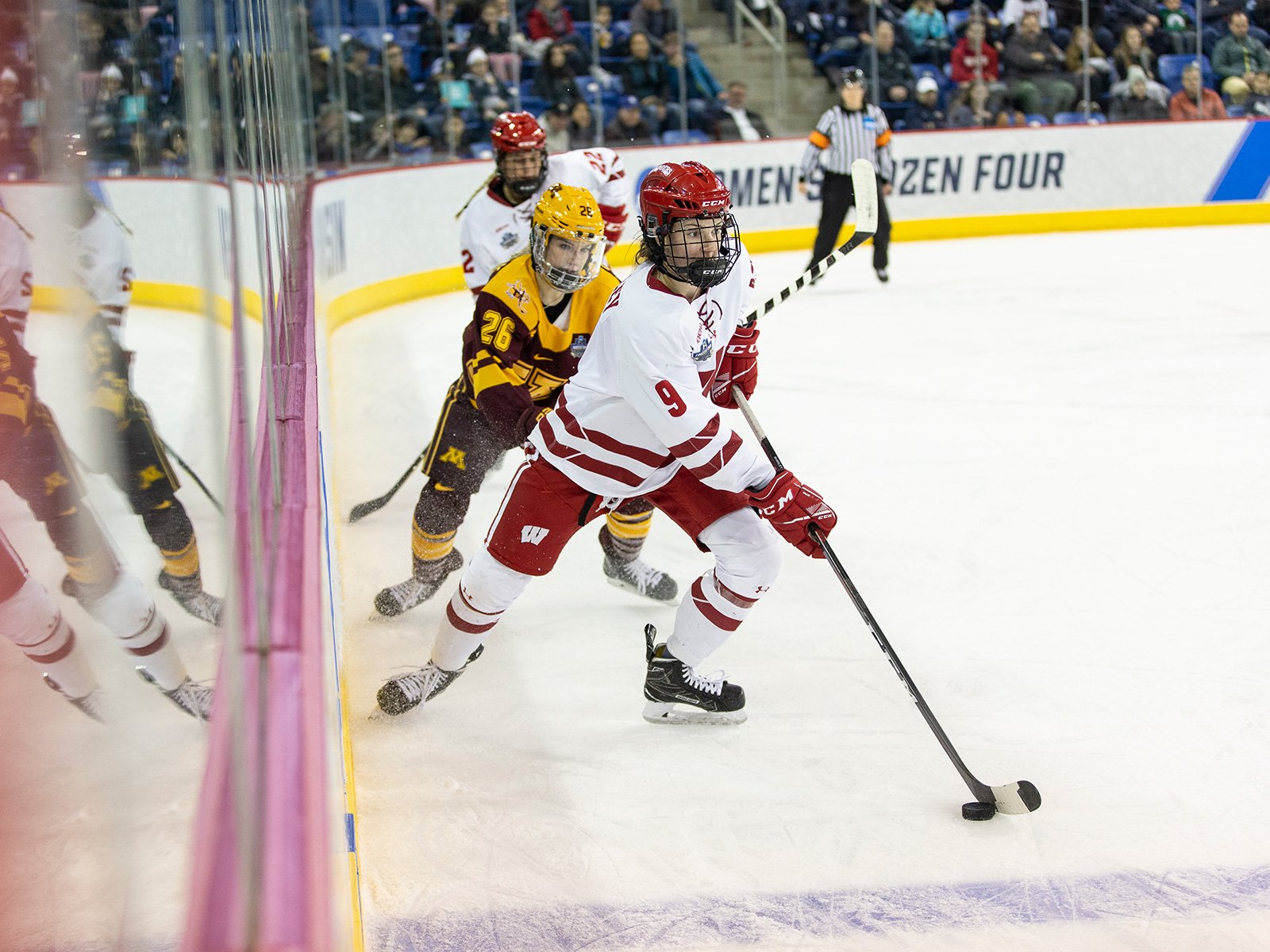
“They Hit You to Hate You”
The Badgers-Gophers rivalry in men’s ice hockey dates to 1922 (a two-game sweep by the Gophers), but from 1936 to 1964 they didn’t play, as Badger athletics discontinued hockey until November 1963.
The apex of the rivalry arrived in the following decade and centered on two larger-than-life head coaches.
Bob Johnson and Herb Brooks had much in common: both had played hockey for the Gophers, and both would coach the men’s hockey Olympic team. They were energetic, quotable, and terrific coaches. There was one more thing.
“History tells us they’re probably two of the greatest American coaches ever,” says sportswriter Brophy, who knew and covered them both. “But they truly didn’t like each other.”
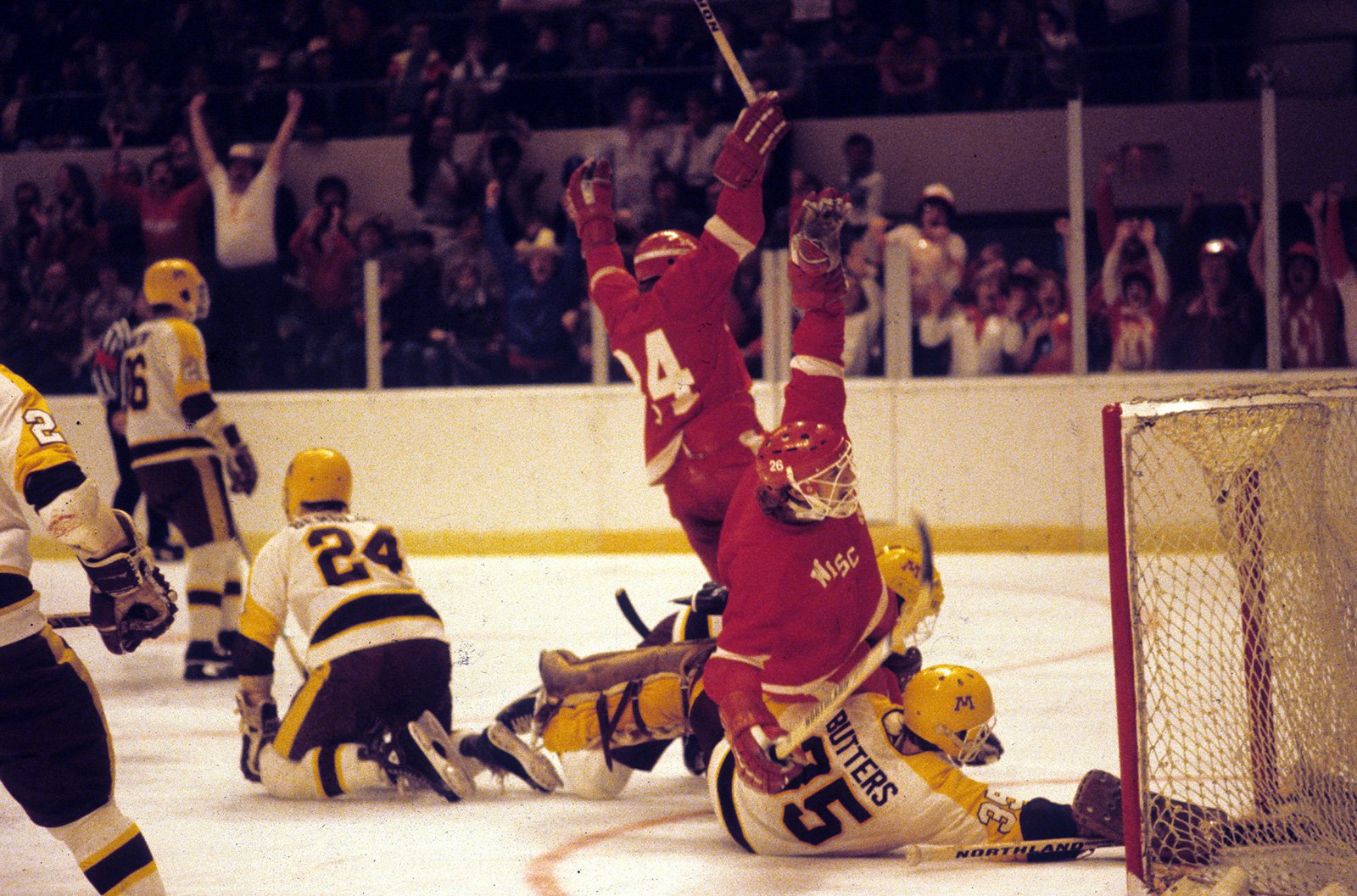
In the 1970s, Johnson coached the Badgers and Brooks the Gophers.
“I was struck with the level of dislike between the two programs,” Brophy says.
Mike Eaves ’78 was a star player for the Badgers team that won the 1977 NCAA championship. Eaves later coached the Badgers, and in 2002 he spoke to Capital Times sports columnist Joe Hart about the intensity of the Badgers-Gophers hockey rivalry.
Eaves described entering the Minneapolis arena as a player, taking the ice and thinking, “Holy moly, this is hate. … The tenacity on the ice was incredible. When they hit you, they hit you to hate you. It was special.”
In November 1977, eight months after the Badgers won the national title, the Gophers were coming to Madison for a two-game weekend series at the Dane County Coliseum. During the week, at a luncheon in Minneapolis, Brooks made a comment about the Badger hockey fans.
“They get about 8,000 people in there,” Brooks said, “and half of them are drunk.”
Word drifted back to Madison. Some enterprising Badger fans concocted a photo of Brooks sucking on a beer can and distributed copies to fans seated near the Gophers coach.
“There were hundreds of them being held up behind the bench,” Brophy says. “It got to Herb. After the game, in the area where Herb was doing his press conference, some kid from the band asked Herb to sign the photo. Herb grabbed the guy and threw him up against the wall. Then he cooled off. But it was like, ‘Wow!’ It was real. He really didn’t care for Wisconsin and Wisconsin didn’t care for him.”
Ironically, within a few years, Bob Johnson’s son, Mark ’94 — who now coaches the powerhouse Badgers women’s hockey team — would star on the 1980 Olympic “miracle” team that won the gold medal. Their coach? Herb Brooks.
What about the Badgers-Gophers rivalry in men’s and women’s basketball?
Watch video highlights of the teams’ 2025 matchups below!